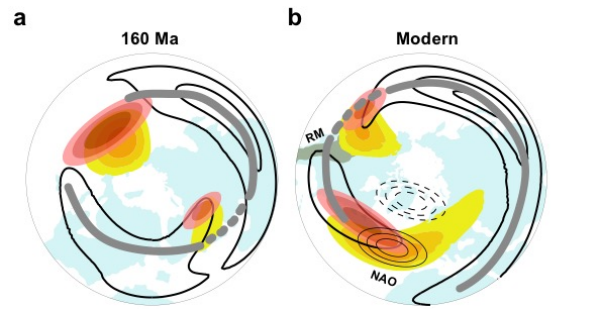Peking University, March 31, 2025: A simulation on the origin and evolution of North Atlantic Oscillation (NAO) has been conducted by a PKU research team led by Nie Ji, Associate Professor of School of Physics, and Hu Yongyun, Dean of Institute of Ocean Research, along with a research team from National Natural Science Foundation of China. Their study, recently published in Nature Communications, reveals the coherent relationship between NAO and the evolution of continents, mountains and oceans.
Why It Matters:
NAO plays a critical role in shaping climate patterns, affecting temperature, precipitation, and storms across regions like Europe, China, and North America. Understanding its geological origins provides insights into past climate variability and helps refine climate prediction models.

Fig. 1: The evolution of the leading empirical orthogonal function (EOF) pattern. The leading EOF (EOF1) of wintertime geopotential height at the 1000 hPa level (Z1000) of (a) the 150 Ma and (b) the 40 Ma cases. The color indicates the zonally averaged EOF1 pattern for the paleoclimate simulations of (c) the default simulations and (d) the flatten-Rocky-Mountain simulations (NRM). The black solid line is the average width (in units of longitude, corresponding to the upper x-axes) of the North Atlantic Ocean between 40°N and 60°N. In (c), the white diagonal denotes EOFs (160 Ma and 130 Ma) that failed to pass the criterion of barotropicity. In (d), the periods from the pre-industrial to 100 Ma are simulated at intervals of 20 Ma, and the periods not simulated are masked in grey.
Methodology
·Time slice simuation t spans from 160 million years ago (Ma) to the present, analyzing how atmospheric pressure patterns evolved as the North Atlantic widened.
·Idealized experiments testing whether a minimum ocean basin width is necessary for NAO formation.
·Rocky Mountain uplift simulations to evaluate how topographic stationary waves influenced NAO internsity after 40 Ma.
Key Findings
·NAO emerged around 80–60 Ma when the North Atlantic expanded to ~40° longitude.
·Land-sea temperature contrast triggered NAO by shaping westerly jets and storm tracks.
·Rocky Mountain uplift (~40 Ma) further intensified NAO.
·Plate tectonics drive atmospheric circulation evolution over geological timescales.
Figure 2: Schematic of Northern Hemisphere atmospheric circulation features: a Is before and (b) is after the expansion of the North Atlantic Ocean. The thick black contour denotes upper tropospheric westerly jet, the yellow color denotes high-pressure anomalies, and the red color denotes storm track. The grey line denotes the waveguide of transient eddy propagation. The continental distribution, westerly, and high-pressure anomalies in (a) are from the results of 160 Ma case, and in (b) are from the modern case. In (b), the meridional diploe of NAO and the Rock Mountains (grey shading) are also plotted.
Future Prospects
Results have some limitations that require further investigation. It’s still needed to explore the evolution of the leading EOF of extratropical geopotential variation across the entire Northern Hemisphere. Further investigations are needed to disentangle the roles of climate, the Tibetan Plateau, and the RM in shaping NH atmospheric circulation.
*This article is featured in PKU News' "Why It Matters" series. More from this series.
Click “here” to read the paper.
Written by: Akaash Babar
Edited by: Zhang Jiang
Source: Department of Atmospheric and Oceanic Sciences, School of Physics

